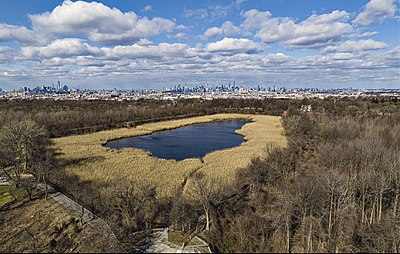Ridgewood Reservoir | |
 Aerial photo showing the three basins of the reservoir with the Manhattan skyline in the background, February 2020 | |
| Location | Jackie Robinson Parkway, Vermont Place, Cypress Hills Street, & Highland Boulevard |
|---|---|
| Coordinates | 40°41′N 73°53′W / 40.69°N 73.89°W |
| Area | 50 acres (20 ha) |
| Built | 1856-1858 |
| Engineer | James P. Kirkwood of H.S. Welles & Co. |
| Architectural style | Romanesque Revival |
| NRHP reference No. | 100002074 |
| NYSRHP No. | 08101.012051 |
| Significant dates | |
| Added to NRHP | February 2, 2018 |
| Designated NYSRHP | December 14, 2017[1] |

Ridgewood Reservoir is a decommissioned 19th century reservoir and freshwater wetland on the border between the New York City boroughs of Brooklyn and Queens, within what is now Highland Park. Although the reservoir was originally built to secure a reliable water supply for the City of Brooklyn, it is positioned on the Queens side of the border in the neighborhood of Glendale. The reservoir and park are bounded on the north by the Jackie Robinson Parkway, on the south by Highland Boulevard, on the west by Vermont Place and on the east by Cypress Hills National Cemetery.
The reservoir was named after the Ridgewood Ponds in Nassau County, which provided the reservoir's eastern water source. Consequently, the neighborhood north of the Reservoir became known as Ridgewood.[2]
Following decommissioning and abandonment, the reservoir naturally became a lush freshwater wetland. This ecosystem attracted a wide variety of fauna and flora, including some threatened and endangered species such as the Short-eared Owl and Pied-billed Grebe.[3] The bicycling trail around the reservoir perimeter became part of the 40-mile (64 km) Brooklyn-Queens Greenway.
Between 2004 and 2017, the Ridgewood Reservoir's future was in question, as the New York City Parks Department and New York State DEC each proposed plans that would have breached the reservoir's basins and disrupted the wetland ecosystem. These plans were dropped after opposition from local community groups who sought to preserve the reservoir's natural setting. In 2018, the reservoir was listed on the National Register of Historic Places and was officially designated by the New York State DEC as a Class I freshwater wetland, ensuring its preservation as a natural space.[4][5][6]
- ^ "Cultural Resource Information System (CRIS)". New York State Office of Parks, Recreation and Historic Preservation. November 7, 2014. Archived from the original on April 4, 2019. Retrieved July 20, 2023.
- ^ Armbruster, Eugene L. (1942). Brooklyn's Eastern District. pp. 324–325.
- ^ "NYC Parks' Ridgewood Reservoir Designated as a Class I Freshwater Wetland" (Press release).
- ^ "National Register Database and Research". U.S. National Park Service. Retrieved February 2, 2021.
- ^ Parry, Bill (February 15, 2018). "Ridgewood Reservoir added to the National Register of Historic Places". Retrieved February 2, 2021.
- ^ Ridgewood Reservoir Historic Register Report (PDF) (Report). United States National Park Service. 2019.


